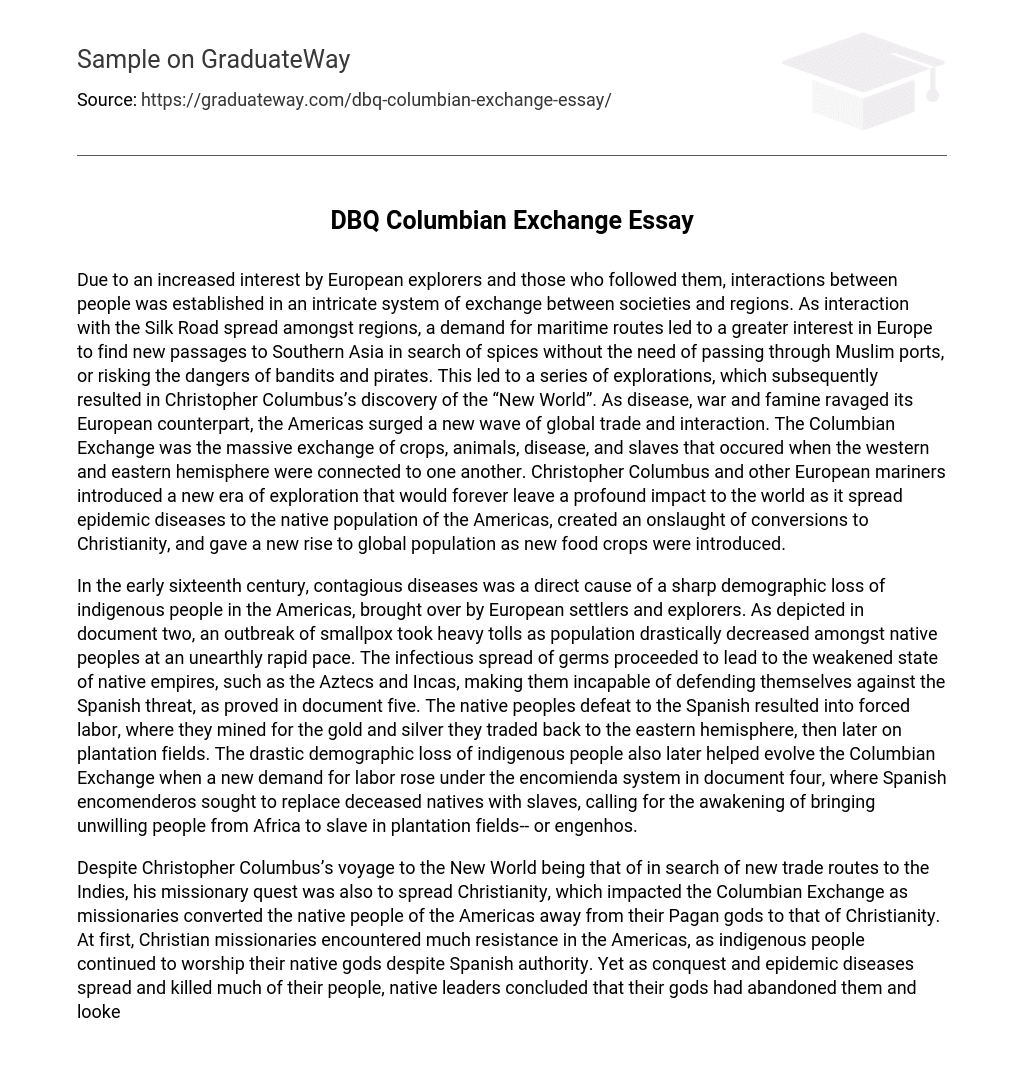Due to an increased interest by European explorers and those who followed them, interactions between people was established in an intricate system of exchange between societies and regions. As interaction with the Silk Road spread amongst regions, a demand for maritime routes led to a greater interest in Europe to find new passages to Southern Asia in search of spices without the need of passing through Muslim ports, or risking the dangers of bandits and pirates. This led to a series of explorations, which subsequently resulted in Christopher Columbus’s discovery of the “New World”. As disease, war and famine ravaged its European counterpart, the Americas surged a new wave of global trade and interaction. The Columbian Exchange was the massive exchange of crops, animals, disease, and slaves that occured when the western and eastern hemisphere were connected to one another. Christopher Columbus and other European mariners introduced a new era of exploration that would forever leave a profound impact to the world as it spread epidemic diseases to the native population of the Americas, created an onslaught of conversions to Christianity, and gave a new rise to global population as new food crops were introduced.
In the early sixteenth century, contagious diseases was a direct cause of a sharp demographic loss of indigenous people in the Americas, brought over by European settlers and explorers. As depicted in document two, an outbreak of smallpox took heavy tolls as population drastically decreased amongst native peoples at an unearthly rapid pace. The infectious spread of germs proceeded to lead to the weakened state of native empires, such as the Aztecs and Incas, making them incapable of defending themselves against the Spanish threat, as proved in document five. The native peoples defeat to the Spanish resulted into forced labor, where they mined for the gold and silver they traded back to the eastern hemisphere, then later on plantation fields. The drastic demographic loss of indigenous people also later helped evolve the Columbian Exchange when a new demand for labor rose under the encomienda system in document four, where Spanish encomenderos sought to replace deceased natives with slaves, calling for the awakening of bringing unwilling people from Africa to slave in plantation fields– or engenhos.
Despite Christopher Columbus’s voyage to the New World being that of in search of new trade routes to the Indies, his missionary quest was also to spread Christianity, which impacted the Columbian Exchange as missionaries converted the native people of the Americas away from their Pagan gods to that of Christianity. At first, Christian missionaries encountered much resistance in the Americas, as indigenous people continued to worship their native gods despite Spanish authority. Yet as conquest and epidemic diseases spread and killed much of their people, native leaders concluded that their gods had abandoned them and looked to the missionaries for spiritual guidance. Provided in document one, European missionaries promoted their religion through peaceful means, gaining the affection of the people with exotic goods. Missionaries themselves learned native languages and sought to explain Christianity in terms understandable to their audience, creating Missions and settlements shown in document six that helped spread Christianity and European languages. The native peoples conversion to Christianity also led to the development of the encomienda system, which prompted Indians that converted to Christianity to live in Christian communities and help build buildings, mine for gold, and work the fields.
As native population diminished in the east, Europe’s population was experiencing a rapid population growth as the global spread of food crops and animals caused by the Columbian Exchange brought radical changes to the life of Europeans. As stated in document three, crops imported from the Americas to Europe consisted of high nutritional value and calories, which allowed people to work harder and develop better immune systems against infectious diseases.
The agricultural production of crops such a potatoes was very popular amongst European peasantry, who adopted American crops into their everyday cuisine. Not only was exchange between the New World to Old World revolutionary, but in reciprocal, trade between the Spanish and natives drastically changed as new technology was introduced in the Americas. Though there were fewer imports than exports to the Americas from the eastern hemisphere, the trade of raw materials for manufactured goods was popular, as seen in document seven, especially the trade of gold and silver which brought vast wealth to the mother country.
While the Columbian Exchange brought forth a new age of exploration and discovery, it’s profound impact on the native population of the Americas still affect people today as it once spread epidemic diseases to indigenous people, converted them to christianity, and led to a population rise as new food crops and technology was introduced. Following the Columbian Exchange, a constant decline in native populations and fall of nations ensued as Europe’s wealth grew. The Columbian Exchange opened new pathways to cultural, social and economic exchange as people all over the world began interacting with one another.





